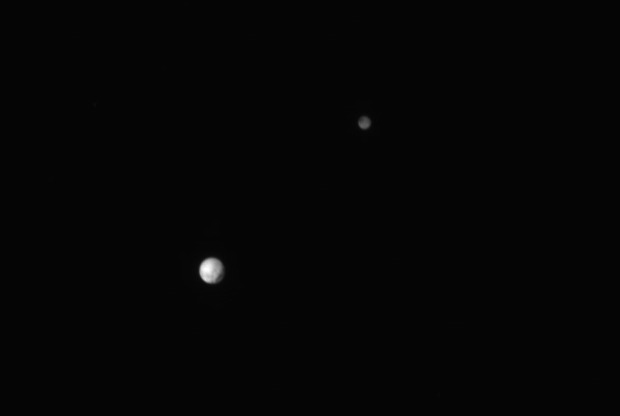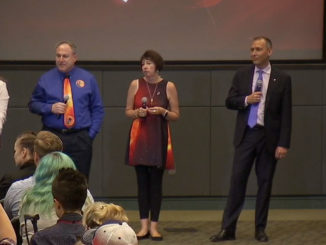STORY WRITTEN FOR CBS NEWS & USED WITH PERMISSION

NASA’s New Horizons probe, now just 10 million miles from Pluto and 14 days from a historic July 14 flyby, is operating in near flawless fashion, making increasingly detailed observations of the enigmatic dwarf planet and its large moon Charon, project engineers and scientists reported Tuesday.
“If you’ve been looking at the pictures on the (New Horizons) website, you can see that Pluto and Charon are becoming more distinct in their surface features,” said mission operations manager Alice Bowman. “Every day is bringing new features into light.”
Streaking through space at more than 30,000 mph, New Horizons is on track to pass within about 7,800 miles of Pluto a few seconds shy of 7:50 a.m. EDT (GMT-4) on July 14. Fourteen minutes later, the spacecraft will pass within 17,900 miles of Charon, the largest of Pluto’s five known moons.
Throughout the encounter, New Horizons will train its cameras and other instruments on Pluto and its retinue of moons for unprecedented close-range observations, revealing a never-before-seen world at the edge of the solar system.
Over the next few days, Bowman said, engineers plan to uplink the complex sequence of commands that will be executed aboard the spacecraft during the flyby. At the same time, they will be analyzing the probe’s flight path to determine whether another small trajectory correction maneuver might be needed to make sure the spacecraft hits the desired close-approach aim point.
But the work is going smoothly, and after a nine-year journey covering some three billion miles since launch in January 2006, the piano-size spacecraft is finally on the doorstep of Pluto, the famously demoted “ninth planet” and the largest known world in the vast Kuiper belt that defines the outer solar system.
Scientists can barely contain their excitement.
“There are features on Pluto that we were starting to see before, and they’re coming into sharper and sharper focus,” Cathy Olkin, the deputy project scientist, said in a NASA update Tuesday. “We see a bright region on Pluto’s north pole, it might be a polar cap, we’re looking to get closer and investigate that further. We’re seeing detailed images of the closest approach hemisphere. There are dark regions and bright regions, and it’s going to be really exciting!”
Pluto and Charon represent a true binary planet. Charon has 12 percent the mass of Pluto and the two orbit a common center of gravity that is above the surface of Pluto. For comparison, Earth’s moon is just 1 percent as massive as its parent and the common center of gravity is well below Earth’s surface.
Scientists are intrigued by “a dark region in Charon’s pole, which is surprising to me,” Olkin said. “A lot of times in polar regions you see bright features like we do on Pluto and Mars and Earth where you have a bright polar cap. But this region is dark compared to the rest of the surface, so it’s very tantalizing. We’re just waiting to get closer and see more about it.”
The first color images from New Horizons show Pluto is distinctly reddish compared to its companion.
“You can see, as Pluto and Charon are both rotating, that Pluto is more red on all the faces compared to Charon being gray,” Olkin said. “This confirms what we knew from ground-based observing, but it’s giving us more and more detail as we get closer and closer.”
At Pluto’s vast distance from the sun it takes radio signals from Earth, traveling at 186,000 miles per second, nearly four-and-a-half hours to reach New Horizons. As such, real-time commanding is not possible and the computer commands needed to accurately aim the spacecraft and its instruments must be uplinked well in advance.
To work properly, New Horizons must have an accurate idea of where it is and a good idea where Pluto is in its orbit. As the flyby approaches, engineers are studying navigation images beamed back from the probe to refine their knowledge of the dwarf planet’s orbit to make absolutely sure New Horizons hits its flyby target.
The next week or so will be particularly busy as the mission enters the home stretch.
“We’re going to be putting up the flyby sequence on board the spacecraft in the next couple of days, to both the primary and backup computers,” Bowman said “There’s a possibility we’ll be doing a trajectory correction maneuver, and of course getting down lots of science data and optical navigation data. It’s going to be great!”
Fran Bagenal, a co-investigator at the University of Colorado, said she doesn’t know what New Horizons might ultimately reveal. But she’s sure it will defy expectations.
“I actually think we have no idea what we’re going to find,” she said. “You see these fabulous paintings people have drawn of icy surfaces, and clouds, and mist, and rocks, and mountains. It could be completely different!
“The satisfaction of the whole mission will come when we see those first pictures and we actually get a glimpse of what the icy surface looks like. It really tells us about how our world, our solar system, formed, and how it got to be the way it is. So it’s cool! Let’s go there. Let’s go explore it.”



